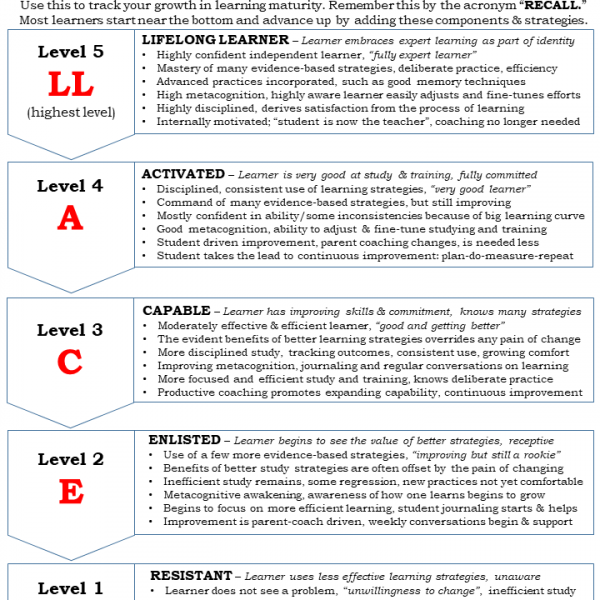
Learning How to Learn Key Terms

Reading time: 8 minutes
How well versed are you in the science of learning? Do you know all of these terms?
| Term | Working Definition |
| Focused Mode Thinking | Associated with the concentrating abilities of the brain’s prefrontal cortex. Uses rational, sequential, analytical approaches. Used for something already connected in your mind. A type of network. |
| Diffuse Mode Thinking | A complex flickering of neural processes in many areas of the brain. Learning occurs here in the subconscious. Happens when you relax your attention and let your mind wander. A type of network. |
| Left (hemisphere) side of brain | Associated with careful focused attention. Specialized for handling sequential information and logical thinking. Some new studies discount the dominance of right and left brain thinking. |
| Right side of brain | Seems more tied to diffuse scanning of the environment and interacting with people. (often called the intuitive side.) The area more associated in processing emotions. Linked with simultaneous big-picture thinking. |
| Working Memory | An inefficient mental blackboard. Holds about 4-7 chunks of information. Primarily in the prefrontal cortex. The learning goal is to move information from short-term to long-term memory. |
| Long Term Memory | Requires practice to store information. Repetition is necessary to freshen it up. Involves connecting ideas to preexisting circuits. Hippocampus important for learning facts and events. When removed = amnesia. |
| Bjork’s Desirable Difficulty Principle | We learn best when we adapt strategies that keep us slightly outside our comfort zone. Expert learners frequently adjust or change strategies to keep themselves in this zone. |
| Chunking | Mental leap that unites bits of information. Don’t confuse a-ha with a chunk. Gaining context helps. Takes a slot in working memory. Pieces of information, neuroscientifically speaking. Involves a bottom-up process. |
| Deliberate Practice | Reference KA Ericsson – the quality of your practice is more important than the quantity. Requires frequent and immediate feedback. (Related to Gladwell’s 10,000 hours.) Can be broken down into five specific components. “The goal is not just to reach your potential, but to build it to make things possible that were not possible before.” |
| Interleaving | Inserting different techniques back and forth to keep the brain slightly outside of its comfort zone. Drawing on chunks in different fields. |
| Einstellung Effect | Where an initially formed idea prevents seeing a better idea. Reinforces the need to keep an open mind. Limits ability to learn. |
| Ebbinghaus forgetting curve | This 150 year old study charts and explains memory decay. Without the use of memory strategies, 50% of memory will decay in 24 hours, and 80% of information in 50 hours. One of the reasons that traditional learning strategies are so ineffective.. |
| 4 Components of Habit | Habits have 4 components. Cue -> Routine -> Reward -> Belief. If you want to successfully change a habit, you have to change your response to the cue. See Charles Duhigg. |
| Habits | These create neurological cravings. Your goal as a lifelong learner should be to transfer sound learning strategies into habits through practice. |
| Law of Serendipity | Lady Luck favors only the one who tries. If you don’t try to improve your ability to learn, you will remain stuck with inefficient practices. |
| Memory Palace Technique | A visual memory pad you create to remember and recall information. Greatly speeds up access to chunks. Has specific rooms each with specific content. Reusable. Used by the ancient Greeks. A tool of memory champions. |
| Metaphor | A useful technique for memory and recall. Word or phrase applied to an object or action which is not literally applicable, symbolic for something else. |
| Metacognition | An important component to expert learning. Having an awareness of how you learn. Necessary for learning how to learn. |
| Analogy | A useful technique for learning where one thing that is compared to something else in significant respects. |
| Process of Learning vs Product of Learning | Lifelong learners emphasize the process of learning. The traditional less effective approach of product emphasizes the end result which can be frustrating. The more effective learner focuses on the learning process itself. |
| Deep Learning | Activities performed in a state of distraction free concentration that push cognitive capacities to the limit. Specific requirements. Reference Cal Newport. |
| Attention Residue | A problem with multitasking. It is the cost of switching tasks, “reside slathering interruptions.” Recovery can take up to 20 minutes or longer to restore concentration. |
| High Quality Work Formula | (Time Spent) x (intensity of focus) = results. Emphasizes the need to stay slightly outside your comfort zone when learning. |
| Schema | Mental Framework – very important to helping memorization. |
| Vampires | Naturally dissipating processes in the working memory. Has to do with fatigue. Points to the need for energy management. |
| Reflection | Has two components – retrieval and elaboration. An important tool for learning. Sports teams have learned to do this and spend much time reviewing “tape” to improve performance. |
| Retrieval Practice | A much more effective learning strategy than restudying. Pat of reflection. Another name for self-testing. Is something more difficult to do, but highly effective. See Bjork’s principle. |
| Spaced Practice | A more effective approach to learning than power learning. Example: The reality that 5 one-hour learning sessions spaced apart are more effective than 1 five-hour session. The opposite of cramming. Produces more long-lasting learning. |






